- A Passion for the Planet, composed by Geoffrey Hudson, is an hour-long oratorio on climate change. The lyrics blend together scientific prose, poetry and sacred texts from many faiths.
- Hudson, an American composer, often writes for stringed instruments and has had his work performed across the US and Europe.
- The piece is scored for a chorus of mixed voices, a children’s chorus, soprano and baritone soloists and a 12-member instrumental ensemble. It premiered in Northampton, Massachusetts, USA in June 2019.
- You can watch a live recording of the piece here and you can read the lyrics here.
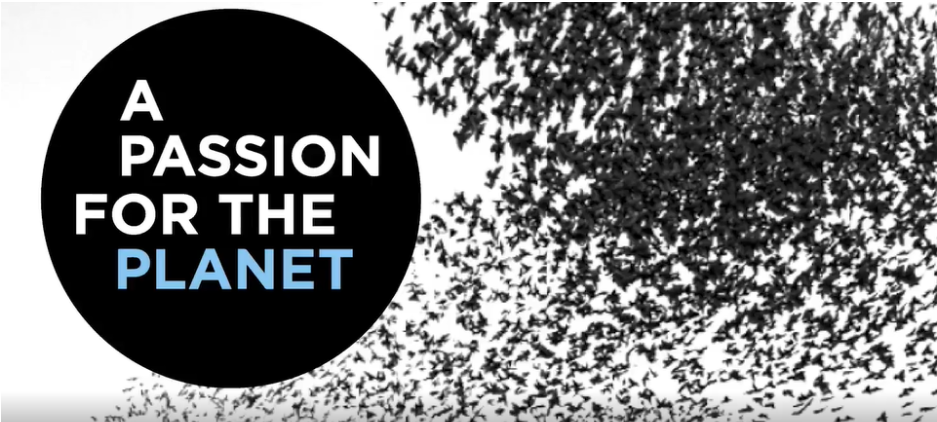
How is this related to climate?
- The 11-movement piece traces an emotional arc inspired by climate change in three parts:
- The beginning celebrates the natural wonders of Earth.
- Movement I, called “Everything We Need,” praises the Earth for being plentiful and providing for all people. Long, gentle, high-pitched notes, crescendos and a fast tempo convey a reverent and exultant tone. Words such as “joy,” “gladness,” “praise” and “blessings” are repeated.
- The middle movements explore the dark realities of climate change.
- The second movement, titled “In the Briefest Moment in History,” expresses the sentiment that civilizations were thriving for a relatively short period of time, and that this was at the expense of the planet’s health. This movement is very short compared to the others, emphasizing the brevity of this historical moment.
- The beginning celebrates the natural wonders of Earth.
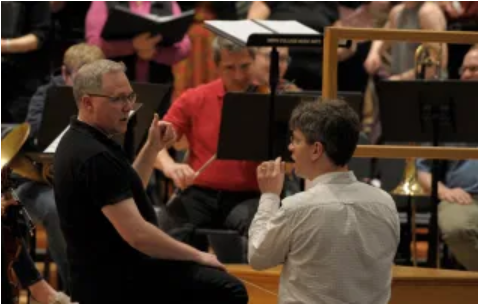
Composer Geoffrey Hudson (right) with conductor Tony Thornton (left) during a rehearsal for the premiere of A Passion for the Planet in June 2019 (from Hybrid Vigor Music, n.d.).
-
-
- Movement III, begins the exploration of climatic and environmental problems facing Earth today through “The Three Gyres” that harm the planet and its people: a gyre of plastic and other debris in the ocean; air pollution and increased carbon dioxide (CO2) levels swirling in the atmosphere and leading to global warming; and chemicals in our blood streams. Dissonance, or a combination of sounds that are intentionally inharmonious, cymbals crashing, lower notes and a slow tempo create an ominous tone that convey the gravity of the situation. The consequences of climate change, such as extreme heat, drought, intense storms and rising seas, are shouted by the singers. Certain words including “stored permanently” and “extreme heat” are repeated for emphasis. Words are sung over each other by different voice parts, creating a sense of chaos.
- In the fourth movement, “A Gift,” gratitude is expressed for life on Earth and to previous generations for protecting the planet. The lyrics speak of pleasures on Earth, including the view from a ridgetop, fireflies on a summer evening and the smell of rain. However, the line “were at least unable to damage more than they did” suggests that previous generations could have done more to preserve nature.
-
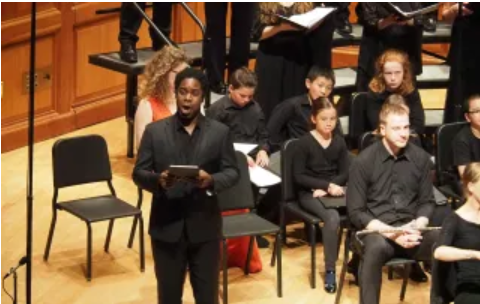
Baritone soloist Dashon Burton singing Movement IV: “A Gift” during the premiere of A Passion for the Planet in June 2019 (from Hybrid Vigor Music, n.d.).
-
-
- “We Are Driving in a Car,” the fifth movement, starts with an alarming boom and crescendos, which build suspense and tension. The lyrics relate the current climate situation to driving in a car that is headed towards a cliff. The cliff represents climate disaster and not putting brakes on the car implies that we are not taking actions that could help us avoid such disaster. The phrases “bad brakes” and “we know for sure” are repeated.
- Movement VI, “Why Should I Bear the Blame?” draws on the anger and frustration some people feel over having to solve a problem that they alone did not create. Short, punctuated words convey these emotions. “Rage,” “accuse” and “redeem” are emphasized and repeated.
- The seventh movement, “The Ice Caps Are Melting,” is inspired by the “hockey stick graph” (below) published by Michael Mann and his research collaborators in 1998 and popularized by former presidential candidate Al Gore in the 2006 film An Inconvenient Truth. The graph, which is shaped like a hockey stick, shows the trend in average temperatures from 1000 to 2000 CE: a period of relative stability from 1000 to around 1900 CE before spiking in the last 100 years. The instrumental music of this movement translates climate-related data that follow this trend into sound: pitch corresponds to atmospheric carbon dioxide levels, the number of notes per measure corresponds to global extinction rates and the volume corresponds to human population. Following the trends in these data from 1640 to 2070, the movement starts low, slow and quiet and becomes increasingly higher, faster and louder before spiraling out of control. The choral music offers additional verbal and non-verbal commentary: “business as usual” suggests that not enough is being done to mitigate climate change; “families must flee” and the image of people fighting over “hot, poor, shrinking land” highlight the social impacts of climate change; the words “too hot, too cold, too dry, too much, too little, too late, too soon” are repeated, chanted and sung over each other, creating a sense of chaos and urgency.
-
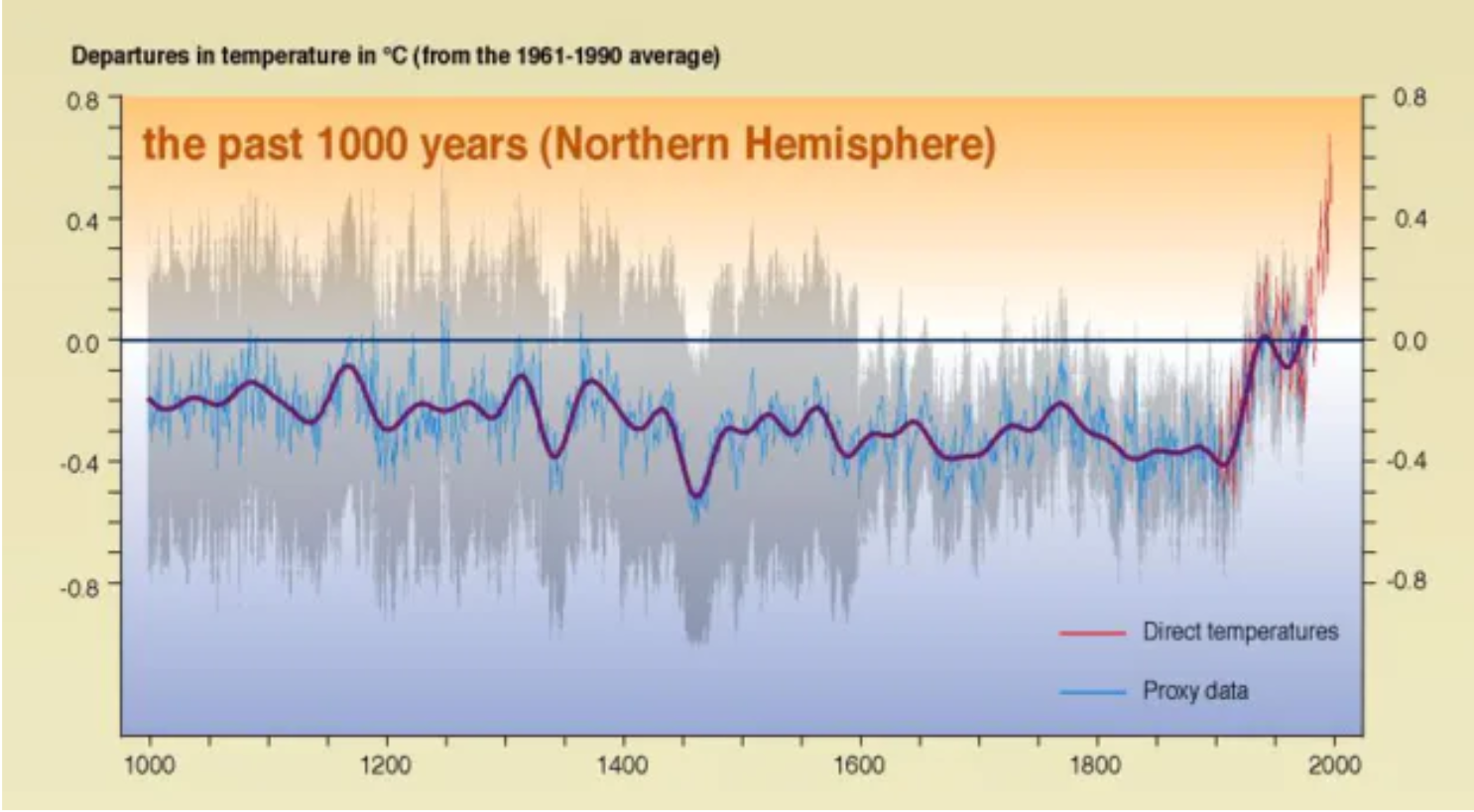
The famous hockey stick graph from Mann et al. (1998) showing the trend in average temperatures for the Northern Hemisphere. Note the relative temperature stability from the year 1000 to around 1900 CE before spiking in the last 100 years. The horizontal black line (labeled 0.0 along the vertical axis) is the average temperature between 1961 and 1990, which is used as a reference temperature to illustrate fluctuations in documented values through time. Sources for proxy temperature data include tree rings, ice cores, lake sediments and historical records (from Inverse, n.d.).
-
- The ending, beginning with the eighth movement, turns towards hope.
- In the eighth movement, “The Question,” the children’s chorus asks what people have done with the world that they must inherit. The slow and gentle notes create a sorrowful tone. “What have you done” is repeated over and over, drawing on a sense of disbelief over what has happened to the planet.
- The ending, beginning with the eighth movement, turns towards hope.
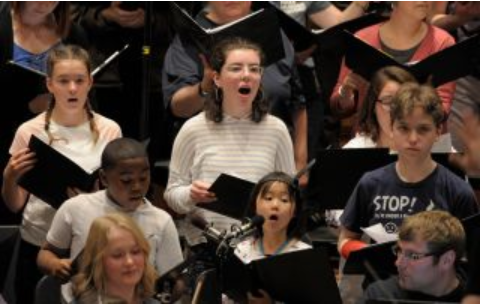
Members of the Hampshire Young People’s Chorus rehearsing for the premiere of A Passion for the Planet in June 2019 (from Hybrid Vigor Music, n.d.).
-
-
- “Hope is A Verb” is the ninth movement, which is inspired by the following quote from Professor Emeritus of Environmental Studies and Politics at Oberlin College David Orr: “Hope is a verb with its sleeves rolled up.” “Hope” is repeated many times, inspiring optimism. The lyrics tell the audience that addressing the current climate situation will require patience, courage and hard work.
- Movement X, “Nothing That Is Worth Doing,” encourages action against climate change by saying that it is meaningful even though we may never personally see the benefits. Words such as “hope,” “love” and “faith” convey a hopeful message.
- At the very end, all the performers and the audience join together to sing a simple chorale tune.
- The eleventh and final movement, “Holy Earth, Ancient Home,” is a reverent plea to the Earth to help us fix what we have done to it. The lyrics praise Earth, referring to it as holy. Everyone singing together symbolizes all people joining together for the planet.
-
- In general, most of the words are sung slowly, communicating the seriousness of climate change.
- Hudson hopes that his piece will connect people emotionally to climate change in order to help them confront and better engage with its many unpleasant realities.
Further Exploration
- You can watch interviews with the composer and singers here: https://www.hybridvigormusic.org/our-projects/a-passion-for-the-planet/.
References and additional resources
- “A Passion for the Planet.” Hybrid Vigor Music. n.d. https://www.hybridvigormusic.org/our-projects/a-passion-for-the-planet/.
- “Chilling the Climate Change Deniers.” Inverse. n.d. https://www.inverse.com/article/26429-michael-mann-climate-change-denial-defamation-libel.
- “Geoffrey Hudson.” Geoffrey Hudson. n.d. https://www.geoffreystephenhudson.com/.
- Mann, M., et al. “Global-scale temperature patterns and climate forcing over the past six centuries.” Nature, vol. 392, 1998, pp. 779-787. DOI: https://doi.org/10.1038/33859.
- Ruch, L. M. “A Passion for the Planet: Raising Environmental Consciousness Through the Melding of Music and Science.” Oh! The Humanities. 2021. https://oth.thirdchapter.org/features/a-passion-for-the-planet-raising-environmental-consciousness-through-the-melding-of-music-and-science/.
